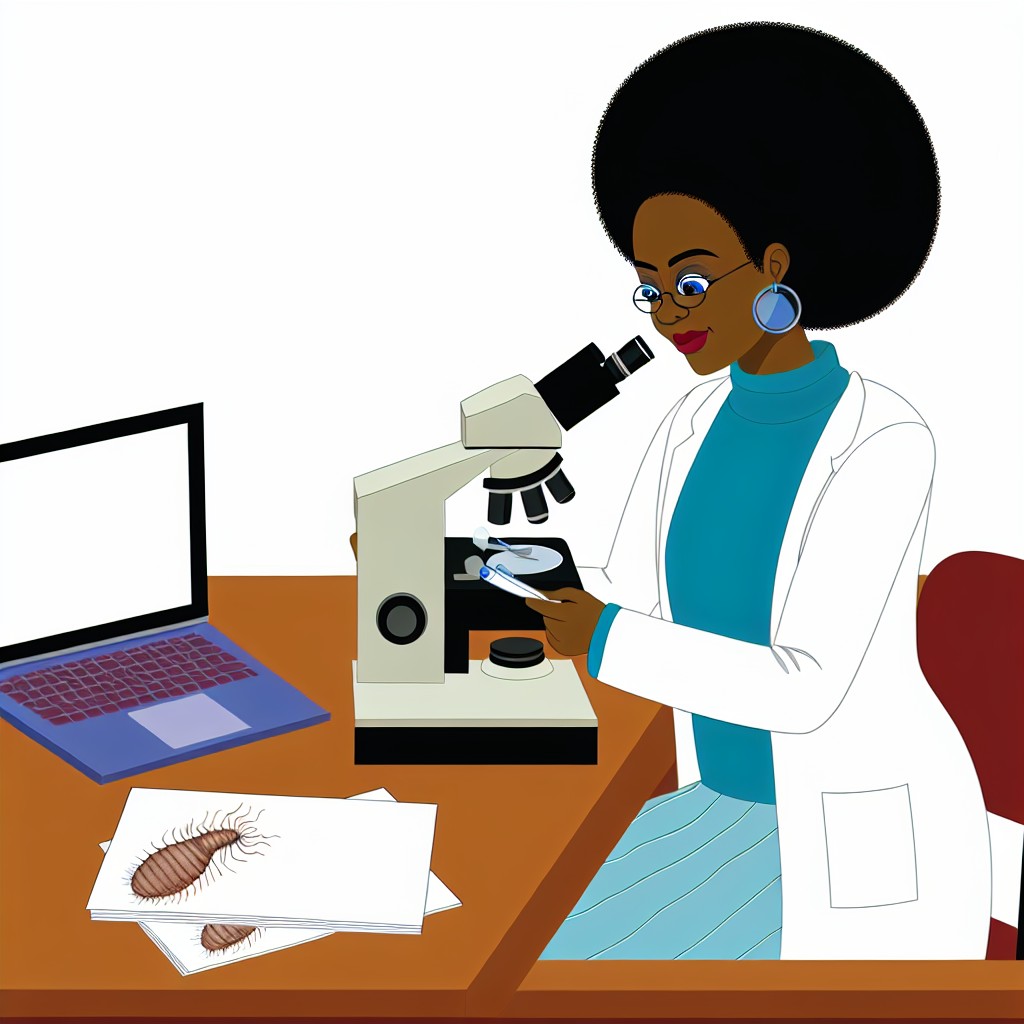Introduction
Parasitology in Nigeria focuses on studying various parasites affecting humans and animals.
Case studies play a crucial role in parasitology research by providing in-depth analysis and insights into parasite-host interactions.
Parasites are a significant public health concern in Nigeria.
They cause diseases like malaria, schistosomiasis, and soil-transmitted helminths.
Through case studies, researchers can better understand the transmission patterns of parasitic infections.
These studies also help evaluate treatment efficacy and prevention strategies for these infections.
In Nigeria, parasitology case studies help healthcare professionals diagnose parasitic diseases effectively.
They also contribute to managing parasitic diseases more efficiently.
These studies support the development of new drugs and vaccines.
As a result, public health outcomes improve in the country.
Furthermore, case studies provide valuable information for policymakers and public health authorities.
Authorities use this data to implement targeted control measures.
By analyzing individual cases, researchers identify trends in parasitic diseases.
They also spot risk factors and emerging parasite strains.
This information helps design evidence-based interventions to combat parasitic diseases.
Parasitology case studies from Nigeria advance research significantly.
They also shape healthcare policies and enhance understanding of parasitic infections in the region.
Through comprehensive analysis and dissemination of findings, these studies contribute to global efforts in parasite control and elimination.
Malaria in Nigeria
Nigeria is one of the countries most affected by malaria.
Over 97% of the population is at risk.
Presentation of a Specific Malaria Case
A 45-year-old man visited a clinic with fever.
He also experienced chills, headache, and generalized body aches.
Symptoms, Diagnosis, and Treatment
The patient was diagnosed with malaria through a positive blood smear.
The smear showed the presence of Plasmodium falciparum.
He was prescribed artemisinin-based combination therapy.
Impact of Malaria on Public Health in Nigeria
Malaria is a leading cause of morbidity and mortality in Nigeria.
The disease particularly affects children under five years old.
It contributes to economic losses in the country.
The healthcare system faces a significant burden due to malaria.
Preventive Measures Against Malaria
In Nigeria, insecticide-treated bed nets are recommended.
Indoor residual spraying is also advised to reduce malaria cases.
Challenges in Controlling Malaria
Drug resistance poses a significant challenge to malaria control.
The healthcare infrastructure is often inadequate.
Funding constraints further hinder malaria control efforts.
Strategies for Effective Malaria Control in Nigeria
Malaria remains a major public health issue in Nigeria.
Efforts to control and eliminate the disease continue actively.
Collaboration between government agencies is essential.
Non-governmental organizations also play a vital role in control programs.
Community participation is crucial for successful malaria control.
Case Study: Schistosomiasis
Schistosomiasis is a parasitic disease caused by blood flukes of the genus Schistosoma.
Transform Your Career with Expert Guidance
Get personalized mentorship consulting that’s tailored to your unique path. Our expert advice is actionable and exclusive.
Get StartedThe disease is also known as snail fever.
It is common in Nigeria, especially in places with poor sanitation.
Limited access to clean water increases the risk of infection.
Overview of Schistosomiasis in Nigeria
- Schistosomiasis is endemic in Nigeria.
- About 29 million people remain at risk of infection.
- The disease mainly affects rural and peri-urban areas with contaminated water bodies.
- Children are especially vulnerable due to frequent water contact.
Case Study of a Schistosomiasis Patient in Nigeria
A 10-year-old boy from a rural village in the Niger Delta presented symptoms.
He suffered from abdominal pain, bloody urine, and fatigue.
Investigation revealed he regularly swam in a river infested with Schistosoma parasites.
Tests of stool and urine samples confirmed Schistosoma eggs presence.
The diagnosis confirmed schistosomiasis infection.
Transmission, Symptoms, and Treatment of Schistosomiasis
- Transmission occurs when parasites enter the human body via the skin in freshwater.
- Symptoms include abdominal pain, bloody stool or urine, fatigue, and enlarged liver and spleen.
- Treatment involves praziquantel medication, which effectively kills the parasites.
Measures to Control Schistosomiasis in Nigeria
- The government performs mass drug administration in high-risk regions.
- Awareness programs educate communities about avoiding contaminated water.
- Efforts focus on improving clean water access and sanitation facilities in endemic areas.
Schistosomiasis remains a major public health issue in Nigeria.
However, continued prevention and treatment efforts can reduce the disease burden.
See Related Content: Post-Surgery ENT Check-ups: Importance in Nigeria
Case Study on Onchocerciasis
Onchocerciasis is commonly known as river blindness.
The disease is caused by the parasitic worm Onchocerca volvulus.
Transmission occurs through bites of infected black flies.
These black flies are primarily of the Simulium species.
Introduction to Onchocerciasis in Nigeria
Nigeria is one of the African countries affected by onchocerciasis.
Endemic regions are mostly found in the savannah areas.
The disease poses a significant public health challenge in these communities.
Presentation of a Specific Case Study on Onchocerciasis
A 45-year-old farmer from a remote northern Nigerian village sought medical help.
He suffered from severe itching, skin rashes, and visual impairment.
The symptoms had lasted for several years.
This condition affected his ability to perform work.
Symptoms, Diagnosis, and Treatment Options Explained
Doctors diagnosed the farmer with onchocerciasis based on symptoms and skin snip tests.
Ivermectin was prescribed as the drug of choice to treat this disease.
This medication effectively kills the parasite larvae, called microfilariae.
Regular ivermectin administration controls symptoms and stops disease progression.
However, ivermectin does not kill the adult worms.
Impact of Onchocerciasis on Affected Communities in Nigeria
The disease profoundly affects communities beyond physical symptoms.
It causes skin lesions, blindness, and social stigma for affected individuals.
This stigma leads to discrimination and isolation from social interactions.
Such exclusion hinders full participation in daily activities.
Vision loss severely impacts livelihoods, especially for farmers and visual-dependent workers.
Without proper treatment and community support, individuals experience declining quality of life.
The disease also imposes economic burdens due to reduced productivity.
Controlling onchocerciasis requires sustained public health efforts in Nigeria.
Effective diagnosis, treatment, and community interventions can reduce disease impact.
Healthcare providers, policymakers, and communities must collaborate closely.
Raising awareness and improving treatment access are essential strategies.
These actions will improve health outcomes and support affected individuals’ well-being.
Explore Further: Role of Physiotherapists in Nigerian Healthcare
Case Study on Helminth Infections in Nigeria
Helminth infections affect many people in Nigeria.
They are especially common in rural areas.
Sanitation and hygiene practices there may be poor.
The most common helminths include roundworms, tapeworms, and flukes.
Case Study Details of Helminthiasis
A 35-year-old woman visited a clinic in Lagos.
She complained of abdominal pain, bloating, and diarrhea.
She was diagnosed with helminthiasis, specifically hookworm infection.
Types of Helminths with Symptoms and Treatment
- Roundworms (Ascaris lumbricoides): Symptoms include abdominal pain, diarrhea, and nutritional deficiencies.
- Tapeworms (Taenia solium): They cause weight loss, abdominal pain, and nausea.
- Flukes (Schistosoma spp.): Symptoms include abdominal pain, fever, and liver enlargement.
Strategies to Prevent Helminth Infections in Nigeria
Prevention involves multiple effective approaches.
- Improving sanitation: Promoting proper waste disposal and access to clean water reduces risk.
- Educating the public: Health education programs raise awareness about hygiene and deworming.
- Deworming campaigns: Mass administration of anthelmintic drugs helps control infections.
- Health screenings: Regular screenings detect infections early and enable prompt treatment.
Helminth infections present a significant health burden in Nigeria.
Their impact can be reduced with proper measures and treatment.
Uncover the Details: Preparing Children for ENT Surgery in Nigeria

Case Study 5: Trypanosomiasis
Trypanosomiasis is also known as sleeping sickness.
This parasitic disease is caused by the Trypanosoma parasite.
In Nigeria, trypanosomiasis is primarily caused by two species of the parasite.
These are Trypanosoma brucei gambiense and Trypanosoma brucei rhodesiense.
Specific Case Study on Trypanosomiasis Presented
A 48-year-old male farmer from rural Nigeria presented to a local health clinic.
He complained of worsening fatigue, fever, headache, and joint pain.
The patient reported a recent tsetse fly bite while working in the fields.
Symptoms, Diagnosis, and Treatment Options Described
- Symptoms: The patient exhibited classic symptoms of trypanosomiasis, including fever, fatigue, headache, joint pain, and swollen lymph nodes.
- Diagnosis: A blood smear was taken from the patient and examined under a microscope.
- Treatment Options: The blood smear revealed the presence of Trypanosoma parasites in his blood.
- Treatment Options: The patient was started on a course of medication, including pentamidine and suramin, to kill the parasites.
Challenges in Controlling Trypanosomiasis in Nigeria Highlighted
- Lack of Awareness: Many individuals in rural communities are unaware of the risks associated with tsetse fly bites.
- Limited Access to Healthcare: Rural areas in Nigeria often lack adequate healthcare facilities and trained personnel.
- Drug Resistance: There have been reports of drug-resistant strains of Trypanosoma parasites in Nigeria.
- Vector Control: Controlling tsetse fly populations is a difficult task due to vast rural landscapes in Nigeria.
- Socioeconomic Factors: Poverty, limited education, and lack of proper sanitation contribute to the spread of trypanosomiasis.
Trypanosomiasis remains a significant public health concern in Nigeria.
Challenges exist in diagnosis, treatment, and prevention of this disease.
Effective control measures include vector control strategies and improved access to healthcare.
These efforts are essential to reducing the burden of this parasitic disease on the population.
Uncover the Details: How to Apply for Radiography Programs in Nigeria
Parasitic Infections and Research in Nigeria
The case studies highlighted various parasitic infections prevalent in Nigeria.
Studying parasitology cases in Nigeria is crucial for understanding disease burden.
This study helps to understand the transmission of parasitic diseases.
It is imperative to invest in further research to combat parasitic diseases.
Public health interventions must also be expanded to reduce disease impact.
Additional Resources
Impact of training of mothers, drug shop attendants and voluntary …
Post-exposure prophylaxis following occupational exposure to HIV …




